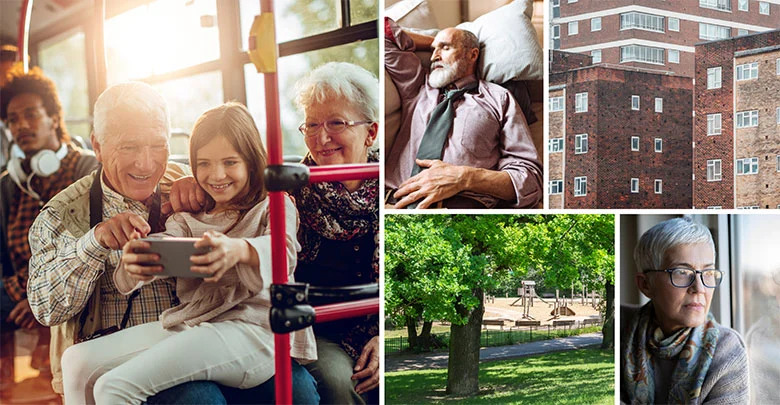Report: Building resilience: being young and getting old in a hotter Europe
As we face heat events of higher intensity and frequency and live in increasingly dense urban neighbourhoods, we must ask ourselves how to best design our living environments for the most vulnerable citizens – our children and the elderly.
Urban areas are home to more of us than ever before – while half of Europeans (52%) were urban dwellers in 1950, the numbers had increased to 74% by 2015, with the trend set to continue.
While our urban areas are increasing in population density, we are also seeing climate threats such as flooding receiving a lot of attention owing to their vast economic impacts. However, the hidden danger – the threat of extreme heat – misses the headlines and attracts disproportionately little media attention. The fact is that more Europeans die from heatwaves than all other natural hazards combined. This includes earthquakes, tsunamis, volcanic eruptions, floods, storms, cold waves, droughts and forest fires.
Heatwaves impact hundreds of millions every year
From 2000 to 2018, floods – a visible threat that governments spend a lot of money on mitigating – killed over 700 people across Europe. But in comparison, in just one year the death toll due to extreme heat across Europe exceeded 70,000 people. This was in 2003, the deadliest year in recent European history (not including 2020 owing to the coronavirus crisis). As well as increasing mortality, heatwaves impact hundreds of millions more every year in the form of health problems, water shortages, power blackouts, wildfires, pollution and infrastructure damage.
Furthermore, when temperatures indoors or outdoors exceed 25°C, worker productivity declines by 2% per degree on average. Such declines in productivity can have huge economic impacts.

Fatalities from natural hazards in 33 European countries during 1980-2017. Fatalities from heatwaves make up 68% of all deaths related to natural hazards.
Urban heat in the future
Extreme heat events – heatwaves, and hot days and nights – will increase in intensity, frequency and duration in the future due to anthropogenic climate change. All of Europe will be affected, the southern and central parts of Europe will encounter the most substantial change in summer temperatures.
Although the specifics are uncertain, current worst-case scenario projections show that 72% of European cities may experience an increase in maximum high temperatures of 10°C by 2100 , compared with historical temperatures (1951-2000). Even if we stabilise carbon emissions, we are still expected to experience higher temperatures and higher extremes in the future.

Impacts on health
Extreme heat events are linked to a multitude of health impacts: dehydration, heatstroke and exhaustion, increases in incidence of disease and increases in premature death. The elderly, infants and young children, those with pre-existing health problems and those in hospital or bedridden are most at risk.
While these groups are physiologically more sensitive to heat, how people subjectively experience heat is also important and depends on a complex interaction of many factors:
- Physiological. Previous long periods of hot weather can result in physical acclimatisation, reducing the negative impact on the human body.
- Local climate. Humidity, air temperature, shading and windchill all impact on how heat is experienced.
- Socio-economic. Being socio-economically disadvantaged affects your experience of extreme heat – for example, due to the quality of available housing, the availability of affordable mitigation measures like air conditioning, and proximity to green spaces.
- Psychological. Spending time in urban greenery can improve perceived well-being, alleviating the perception of thermal discomfort.
While the proportion of younger people in Europe is not set to change, Europe is getting older, and the elderly are particularly at risk. In Europe, the number of people over 65 is rapidly increasing, with those over 80 expected to more than double from 5.6% in 2018 to 12% by 2060.

Urban heat island effect
The urban heat island effect is a phenomenon whereby many cities are warmer than their rural surroundings due to a combination of dark surfaces, high-rise buildings, lack of green space, lack of wind and air pollution trapping heat from the sun, industry, traffic and day-to-day activities.
Many European cities in cooler and more temperate climates were built for staying warm, not for staying cool. Many are full of older buildings, difficult to alter and adapt. Any number of other historical and cultural reasons may mean that we are ill-prepared to manage the impacts of heat. And despite the facts and figures, the problem remains: The threat to the health of vulnerable people has not had much of an impact on policy-making or public awareness. The impacts are still difficult to visualise. What might an increase in summer temperatures or more frequent heatwaves in the future actually feel like for me, my children, my elderly parents and my city?
Visualising heat
One way to visualise the changes that we will experience in the future is to use climate analogues as a tool. These demonstrate the supposed geographic shift cities will experience in the coming years.
The Crowther Lab has done this for 520 major cities across the world, showing the cities (i.e. the analogues) that current cities will most likely resemble by 2050. Some of these shifts for European cities are shown in figure below.
What will the climate of European cities feel like in 2050? What current city represents what this change will feel like?

What the climate of European cities will feel like in 2050 under an optimistic scenario, where we stabilise CO2 emissions by the middle of the century. (RCP 4.5).
Experiencing extreme heat
We know that both the old and the young are more physiologically sensitive. People over the age of 65 are more vulnerable to heat, and this vulnerability increases with age. Infants younger than one are particularly impacted by heat-related mortality due to the weakness of their thermoregulatory systems. The young and the old also experience hot weather in a particular way, depending on their own vulnerabilities and routines and the routines of the people who care for them.
It is important to understand the experiences of the most vulnerable to ensure that we build resilience in a way that adequately caters to their needs.
Older people increasingly live alone, which raises questions about their accessibility to nearby facilities and social integration. They might also rely on caregivers in nursing homes or hospitals, highlighting the importance of healthcare quality and management. Children’s caregivers shoulder a huge responsibility for their well-being since children are unable to care for themselves. Spaces where children spend their time – nurseries, schools and playgrounds – all add to their experience of heat.

Heatwave response and management
As we attempt to build resilience into our urban environments, we must remember the key steps to take. The first approach to building resilience is: be prepared. Data is crucial for increasing the capacity to prepare for challenges. What might a city resilient to extreme heat look like for a 2-year-old and an 80-year-old?
- Prepare: Data is crucial for increasing the capacity to prepare for challenges. In a city with a strong capacity to prepare, the municipality has conducted research on important thresholds and criteria particularly for vulnerable groups. Risk and vulnerability assessments pinpoint the particular threat to our 2-year-old and 80-year-old.
- Absorb the challenges: A city with a strong capacity to absorb can dynamically cope with an extreme heat event, while maintaining public functions and avoiding negative impacts. Our 80-year-olds and 2-year-olds change their behaviour in response to a heatwave, for example by drinking more water, taking midday naps and shifting routines to earlier in the day. Families and communities check on each other.
Our capacity to adapt also involves discovering new solutions and more inclusive practices, through creative and diverse spaces for innovation, experimentation and participation.
Building resilience: being young and getting old in a hotter Europe
Do you have any questions about building resilience? Please contact us
ENRICO MOENS is Program Manager and Senior Expert Climate Change Adaptation in the Urban Planning and Environmental Division at Sweco Netherlands. He holds a degree in Land and Water Management from Wageningen University & Research (WUR). Enrico was key member of the Dutch national knowledge programmes “Living with Water” and “Knowledge of Climate Change and Spatial Planning”. He was one of the founders of the Rotterdam Centre for Resilient Delta Cities (RDC), a triple-helix network of public, private and knowledge institutes.
AMY HAND is an intern in the Urban Planning and Environment Division at Sweco NL. She is currently studying for a MSc degree in Sustainable Development with a specialisation in Earth System Governance at Utrecht University in the Netherlands. Amy holds a BSc degree in Natural Sciences from the University of East Anglia in the UK. She is especially interested in climate adaptation and resilience in urban environments, and her Master’s thesis will be based on the research undertaken for this report.
Other contributing experts
Ann Legeby, Planning Architect, Gothenburg, Sweden.
Lina Hansson – Sweco Sweden
Maria Dolniak – Sweco Poland
Janusz Mizerny – Sweco Poland
Abhishek Parmar – Sweco UK
Gabriela Da Silva Costa – Sweco UK
Lucas Nieuweboer – Sweco Netherlands
Fieke van Leest – Sweco Netherlands


